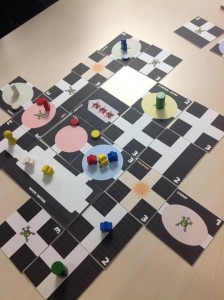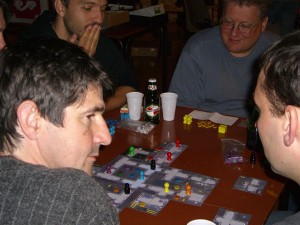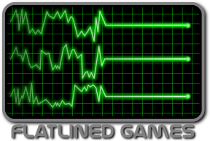Vous vous réveillez dans les pods d’une salle d’hibernation qui ne semble pas tout à fait celle dans laquelle, quelques semaines ou quelques années plus tôt, vous avez été endormis. Vos camarades des autres équipes devant participer à la construction de la nouvelle station spatiale internationale se réveillent à vos côtés. Vous ouvrez paresseusement vos yeux quand soudain des lumières rouges se mettent à clignoter et une voix métallique annonce «présence extra-terrestre détectée, préparez-vous à évacuer la station, autodestruction dans GRRRZZZZRRR minutes».
Space Station Argo – il s’appellera sans doute autrement – est un projet déjà ancien, dont Serge et moi avons réalisé la première version en…. je ne sais plus bien quand, vers 2003 ou 2004. Peu après, nous avions signé un contrat d’édition chez Fantasy Flight Games, qui nous avait demandé d’apporter au jeu quelques modifications, qui l’avaient un peu complexifié. Et puis, après deux ans d’attente, Fantasy Flight a finalement renoncé à publier le jeu, nous avons conservé notre modeste avance et repris nos droits. Depuis, nous l’avions un peu retravaillé, et finalement en 2013, ce jeu a suscité l’intérêt d’un autre éditeur, Flatlined Games, qui devrait le publier en 2014. Flatlined Games est un petit éditeur belge, une entreprise individuelle menée par Éric Hanuise, qui a publié l’excellent Rumble in the House, de Ken Rush, et, plus récemment, Twin Tin Bots, jeu de programmation de Philippe Keyaerts.
Cette fois, il nous a fallu simplifier le jeu, mais ce ne fut en rien un simple retour en arrière. La plupart des ajouts demandés par Fantasy Flight, et notamment l’individualisation des personnages, ont en effet été conservés, mais Eric Hanuise a souhaité accélérer le déroulement des parties et alléger les règles. Ce sont donc la structure des modules de la station spatiale, qui ne sont plus divisés en cases, et les règles de déplacement, qui ont été modifiées. Les modules sont aussi moins nombreux et leurs effets ont un peu changé. Les aliens, qui ne pouvaient apparaître que dans l’un de leurs quatre nids, sont désormais susceptibles de se matérialiser un peu n’importe ou dans la station. Ils peuvent même remporter la partie si les joueurs les y aident un peu en poussant les astronautes adverses dans leurs bras, ou dans un téléporteur en dérangement. Et nous continuons à bricoler un peu le prototype pour rendre les choses plus simples, plus méchantes et plus drôles encore.
Flatlined est un petit éditeur, aux moyens limités, et la publication d’Argo aura vraisemblablement recours, selon la mode actuelle, au «financement participatif» sur Kickstarter ou Ulule. Après l’expérience un peu désagréable de Formula E, je m’étais promis de ne plus avoir de jeu publié selon ce système, mais il semble trop se répandre pour qu’il soit possible d’y échapper. D’ailleurs, je continue moi-même à l’encourager en «pledgeant» régulièrement des jeux qui m’attirent (le dernier, il y a quelques jours, était l’excellent Two Rooms and a Boom), et je continue à penser que le principe est excellent. Il est juste psychologiquement beaucoup plus confortable pour le souscripteur que pour l’auteur, et sans doute que pour l’éditeur.
You’re waking up from the hibernation pods. The hibernation room doesn’t look like the one in which you were being sent to sleep. In the nearby pods, your comrades from the other national teams that are to help you build build the new international space station are also slowly emerging from their pods. You’re eyes are not yet completely open when alarms start flashing red and a metallic voice shouts from the loudspeakers « alien presence detected, evacuation in progress, self destruction in GRRRRZZZRRRRR minutes».
Space Station Argo – it will probably have some other name – is an old game design by Serge Laget and I. We made the first version of it in 2003 or 2004. Soon after this, we signed a publishing contract with Fantasy Flight Games, which asked us to make some change to the game rules, mostly adding more variety and making it a bit more complex. Then, after two years, Fantasy Flight finally resigned, we got our rights back and kept our modest advance. Since then, we had regularly worked on it, trying to find a new publisher. It will finally be Flatlined games. Flatlined Games is a small Belgian publisher, the one person company of Eric Hanuise, who has published Ken Rush’s outstanding Rumble in the House, and more recently Philippe Keyaert’s programming board game Twin Tin Bots.
This time, we had to make the game simpler, but it wasn’t just moving back to our original version. Most of the changes initiated by Fantasy Flight, and first of all the different abilities of characters, are still there, but Philippe wanted to make the game faster and the rules simpler and more consistent. This was achieved through lots of changes, some minor, some more important. The station’s modules are no more divided in spaces, and the movement rules have been completely revamped. There are fewer modules, and their effects have sometimes changed. Aliens, which could appear only in one of their four nests, can now materialize almost anywhere in the station. They can even win the game if the players help them a bit, pushing opponents astronauts towards them or into dysfunctional teleporters. And we’re still working on the prototype to make the game even more fun, simple and nasty.
Flatlined is a small publisher, with limited means, and Argo will probably be published using crowdfunding, as is becoming more and more usual. I didn’t like my first experience of this, with Formula E, but it looks like it’s becoming impossible to always avoid it. Furthermore, if I didn’t like it as an author, I like it as a gamer and still regularly pledge for games that look interesting (the last being the outstanding Two Rooms and a Boom, a few days ago). It’s just psychologically much more comfortable for the pledger than it is for the designer or for the publisher.




Pingback: Bruno Faidutti nos lleva al espacio en su próximo juego - LudoNoticias
Just found this page, researching the new Kickstarter project. I am curious about your hesitation with crowdfunding. Someone has to lay out the money to produce and print things; obviously Fantasy Flight wasn’t sure enough about your game to take the gamble. The benefit of crowdfunding is that you might find enough individuals willing to take the gamble. For example, I’d buy a game with your name on it for $35 in a store, so I’m willing to gamble the same $35 on an untried game from you (even with the negative suggestion of FFG having dropped it); and if enough people are willing to gamble, then we have essentially formed a temporary cooperative to produce this game, hiring Flatlined to be our “general contractor”. You get to publish and profit, Flatlined has presumably priced in some profit, and we get a game. It would be even better if you could do this yourself, but there are complexities dealing with money, and that’s why Kickstarter also makes its fees. So everybody gets something out of the deal. What is your hesitation?
My first issue is very personal – I feel uncomfortable promoting my game in bland, direct and urgent way required by a Kickstarter campaign.
My second issue is more general – a kickstarter campaign costs some money, and lots of time, hours of work. This is a monstruous waste of energy, energy that could be spent on more productive work, such as working on the games themselves and not on the campaign.
So, it’s not really about money, or not mostly about money.